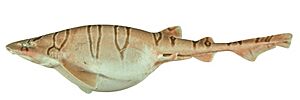Australian reticulate swellshark facts for kids
Quick facts for kids Australian reticulate swellshark |
|
|---|---|
 |
|
| Conservation status | |
| Scientific classification | |
| Genus: |
Cephaloscyllium
|
| Species: |
hiscosellum
|
The Australian reticulate swellshark (Cephaloscyllium hiscosellum) is a type of catshark. It is not very well known. You can find it off the coast of northwestern Australia. It lives deep in the ocean, about 290 to 420 meters (950 to 1,380 feet) down.
This shark has a strong, thick body. Its head is short and wide, with a big mouth. It has cool dark brown lines on its back. These lines look like empty saddles and thin rings on a light background. Like other swellsharks, it can puff itself up. This helps it scare away predators. It lays eggs.
Contents
How the Swellshark Got Its Name
For a while, people thought this shark was the same as another one. That shark is called the reticulated swellshark. It lives near Vietnam and Hainan. But in 2008, two scientists, William White and David Ebert, said it was a different species. They wrote about it for the CSIRO.
The shark's scientific name is hiscosellum. This name comes from two Latin words. Hisco means "open" and sella means "saddle". This name describes its unique color pattern. The first shark studied was a 46 cm (18 in) long male. It was caught west of Leander Point, Western Australia.
What Does the Swellshark Look Like?
Male Australian reticulate swellsharks can grow up to 46 cm (18 in) long. Females can be a bit bigger, reaching about 52 cm (20 in). This shark has a thick body. Its head is short, wide, and very flat. The front of its snout is round.
Its nostrils have skin flaps on the sides. Its eyes are like slits and are high on its head. Behind the eyes are tiny holes called spiracles. The mouth is long, wide, and curved. It does not have grooves at the corners. When its mouth is closed, you can see its upper teeth.
This shark has many rows of teeth. Females have much smaller teeth than males. Each tooth has three points. Sometimes, it has one or two extra small points on the sides. The fourth and fifth pairs of gill slits are shorter. They are located above the base of its pectoral fins.
Its pectoral fins are small, narrow, and have sharp corners. The pelvic fins are also small. Males have long, thin parts called claspers on their pelvic fins. The first dorsal fin is rounded at the top. It starts over the back half of the pelvic fins.
The second dorsal fin is much smaller and shaped like a triangle. The anal fin is larger than the second dorsal fin. It is placed slightly behind it. The caudal fin (tail fin) is medium-sized. It has a clear lower part and a strong notch near the tip of the upper part.
The shark's skin has tiny, arrowhead-shaped scales. These are called dermal denticles. Males have a ridge down the middle of each scale. Females have ridges down the middle and on the sides. The shark is light gray to brownish on top. It has narrow dark lines that form open saddles and thin rings. These patterns go from its head to its tail. Some sharks have small yellow spots. Others have a dark ring or spot on each pectoral fin. Its underside is a plain beige color.
Where Does the Swellshark Live?
The Australian reticulate swellshark lives only off the coast of northwestern Australia. Its home range is between Geraldton and Broome. It lives on the upper part of the continental slope. This means it lives in deep water, from 290 to 420 meters (950 to 1,380 feet) deep.
Life Cycle and Habits
We do not know much about the daily life of the Australian reticulate swellshark. Like other swellsharks, it can fill itself with water or air. This is a way to defend itself. When it puffs up, it looks bigger and scarier to predators.
This shark lays eggs. Its eggs are inside smooth, light yellow cases. These cases are shaped like a flask. They have a flat edge and horns at the corners. These horns have long, curly threads. These threads help the egg case attach to things on the seafloor. Young sharks seem to hatch without a special tooth. Other swellsharks use this tooth to break out of their egg case. Male sharks are ready to mate when they are between 39 and 46 cm (15 and 18 in) long.
Swellsharks and People
The International Union for Conservation of Nature (IUCN) has looked at the Australian reticulate swellshark. They found that there are very few threats to this shark. Because we do not have enough information about it, they have listed it as "data deficient." This means more research is needed to know its true conservation status.


